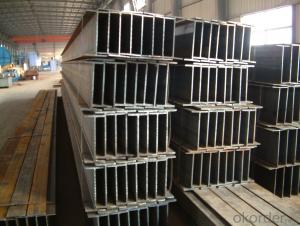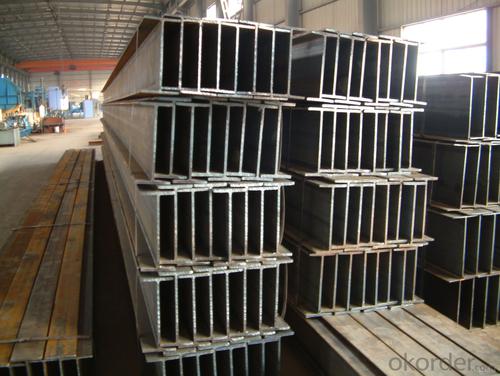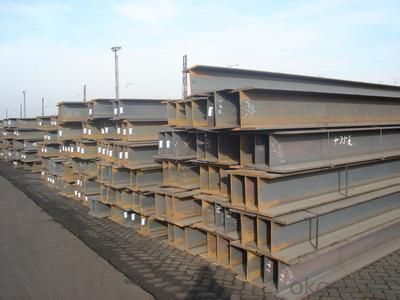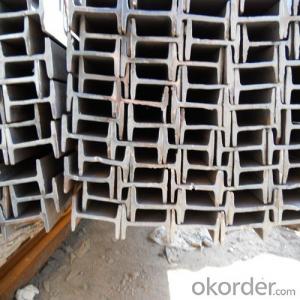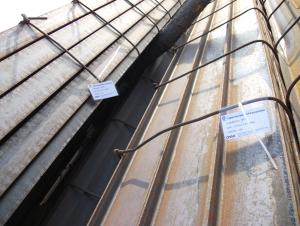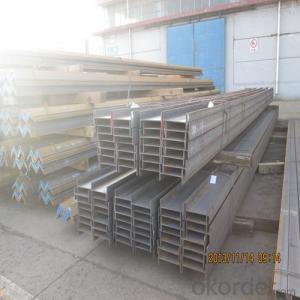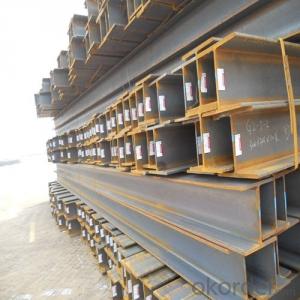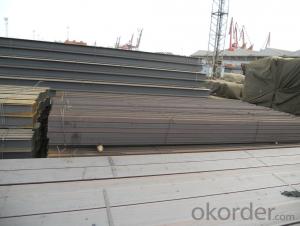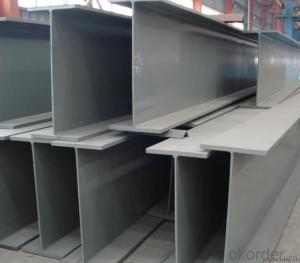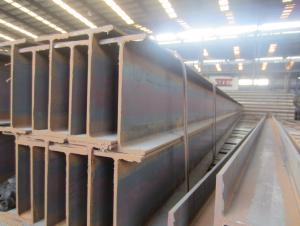Hot Rolled Metal Steel H Beams
- Loading Port:
- China Main Port
- Payment Terms:
- TT or LC
- Min Order Qty:
- 100 m.t.
- Supply Capability:
- 10000 m.t./month
OKorder Service Pledge
OKorder Financial Service
You Might Also Like
Product Description:
OKorder is offering Hot Rolled Metal Steel H Beams at great prices with worldwide shipping. Our supplier is a world-class manufacturer of steel, with our products utilized the world over. OKorder annually supplies products to African, South American and Asian markets. We provide quotations within 24 hours of receiving an inquiry and guarantee competitive prices.
Product Applications:
Hot Rolled Metal Steel H Beams are ideal for structural applications and are widely used inindustrial plants, civil construction, municipal works, oil platforms, bridges, flatbed beams, electrified railway power stand, railway bridges and other light steel structure, super-light H-beam is ideal for containers, mobile homes , all kinds of garage, box-type trains, electrical bracket, various venues, small villa manufacturing etc.
Product Advantages:
OKorder's Hot Rolled Metal Steel H Beams are durable, strong, and wide variety of sizes.
Main Product Features:
· Premium quality
· Prompt delivery & seaworthy packing (30 days after receiving deposit)
· Can be recycled and reused
· Mill test certification
· Professional Service
· Competitive pricing
Product Specifications:
Manufacture: Hot rolled
Grade: Q195 – 235
Certificates: ISO, SGS, BV, CIQ
Length: 12m, as per customer request
Packaging: Export packing, nude packing, bundled
SIZE(mm) | DIMENSION(kg/m) |
100*100 | 16.9 |
125*125 | 23.6 |
150*75 | 14 |
150*150 | 31.1 |
148*100 | 20.7 |
198*99 | 17.8 |
200*100 | 20.9 |
248*124 | 25.1 |
250*125 | 29 |
300*150 | 36.7 |
298*149 | 32 |
200*200 | 49.9 |
294*200 | 55.8 |
346*174 | 41.2 |
350*175 | 49.4 |
244*175 | 43.6 |
175*175 | 40.4 |
294*200 | 55.8 |
298*201 | 64.4 |
346*174 | 41.2 |
350*175 | 49.4 |
400*200 | 65.4 |
396*199 | 56.1 |
450*200 | 74.9 |
446*199 | 65.1 |
340*250 | 78.1 |
500*200 | 88.1 |
300*150 | 36.7 |
FAQ:
Q1: How many tons of steel products could be loaded in containers?
A1: Usually the steel products are delivered by bulk vessel because of the large quantity and the freight. However, there are no bulk vessel enter some seaports so that we have to deliver the cargo by containers. The 6m steel product can be loaded in 20FT container, but the quantity is changed according to the size, usually from 18tons to 25tons.
Q2: How do we guarantee the quality of our products?
A2: We have established an advanced quality management system which conducts strict quality tests at every step, from raw materials to the final product. At the same time, we provide extensive follow-up service assurances as required.
Q3: How soon can we receive the product after purchase?
A3: Within three days of placing an order, we will arrange production. The normal sizes with the normal grade can be produced within one month. The specific shipping date is dependent upon international and government factors, the delivery to international main port about 45-60days.
Images:
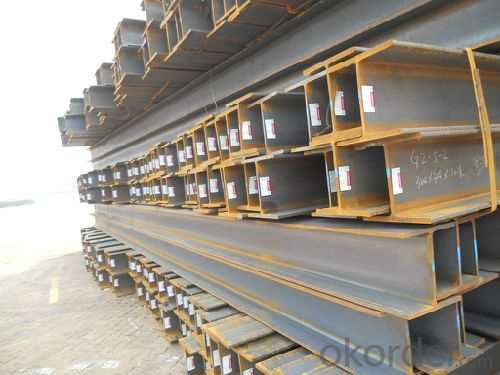
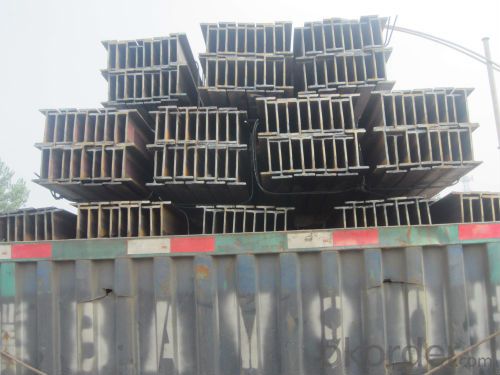
- Q: How do steel H-beams perform in terms of durability?
- Steel H-beams are renowned for their exceptional durability. Their composition and design grant them high resistance to bending, warping, and twisting, thus rendering them highly durable even in the most challenging scenarios. Steel H-beams are manufactured using robust and sturdy materials, like carbon steel or alloy steel, renowned for their exceptional strength and longevity. Furthermore, they are commonly hot-dip galvanized or coated with protective finishes, further augmenting their durability by preventing corrosion and rust formation. These characteristics endow steel H-beams with the ability to withstand heavy loads, extreme weather conditions, and other environmental factors, ensuring their long-lasting durability. All in all, steel H-beams are an optimal choice for structural applications that prioritize durability.
- Q: Can steel H-beams be used for supporting agricultural structures?
- Yes, steel H-beams can be used for supporting agricultural structures. They are commonly used in construction due to their strength, durability, and ability to handle heavy loads. Steel H-beams provide stability and structural support, making them suitable for various agricultural applications such as barns, sheds, and greenhouses.
- Q: What is the maximum length of a steel H-beam that can be manufactured?
- The maximum length of a steel H-beam that can be manufactured depends on several factors including the manufacturing process, transportation restrictions, and practical limitations. In terms of the manufacturing process, steel H-beams are typically produced in standard lengths that can vary depending on the specific steel mill or manufacturer. These standard lengths often range from 20 to 60 feet (6 to 18 meters). However, it is important to note that longer lengths can often be custom ordered or fabricated based on specific project requirements. Transportation restrictions also play a significant role in determining the maximum length of a steel H-beam. The length of the beam must be able to fit within the constraints of transportation methods such as trucks, trains, or ships. These transportation methods have their own size limitations, and exceeding these limits may require special arrangements, permits, or even partial disassembly of the beam. Lastly, practical limitations must be considered when determining the maximum length of a steel H-beam. Longer beams can become more challenging to handle, maneuver, and install on construction sites. The weight and size of the beam can make it more difficult to transport and lift into place, potentially requiring specialized equipment or additional manpower. In conclusion, while there are standard lengths for steel H-beams, the maximum length that can be manufactured is influenced by the manufacturing process, transportation restrictions, and practical considerations. Custom orders, transportation logistics, and practical limitations all play a role in determining the maximum length of a steel H-beam.
- Q: How do steel H-beams resist lateral forces?
- Steel H-beams are designed to resist lateral forces through their structural shape and material properties. The H-beam shape itself provides excellent resistance against lateral forces by distributing the load across the entire length of the beam. The horizontal flanges of the H-beam are designed to withstand bending and torsion, while the vertical web connects and stabilizes the flanges, preventing them from buckling under lateral loads. Additionally, the material properties of steel contribute to the H-beam's resistance against lateral forces. Steel is known for its high strength and stiffness, making it an ideal material for structural applications. The strength of steel allows H-beams to withstand large forces without deformation or failure. The stiffness of steel helps to maintain the shape of the beam and prevent excessive deflection under lateral loads. To further enhance the resistance against lateral forces, H-beams can be reinforced with additional bracing or connections. These reinforcements help to distribute the lateral loads more evenly and increase the overall stability of the structure. In summary, steel H-beams resist lateral forces through their structural shape, material properties, and potential reinforcements. The H-beam shape distributes the load, while the strength and stiffness of steel provide the necessary resistance against lateral forces.
- Q: Can steel H-beams be used in the construction of military or defense buildings?
- Yes, steel H-beams can be used in the construction of military or defense buildings. Steel H-beams are known for their high strength and durability, making them suitable for structures that require resistance against extreme conditions and potential threats. Additionally, their versatility allows for flexible design and construction options, making them a reliable choice for military and defense-related projects.
- Q: Are steel H-beams suitable for oil refineries?
- Yes, steel H-beams are suitable for oil refineries. Oil refineries require robust and sturdy structures to support the heavy machinery, equipment, and pipelines used in the refining process. Steel H-beams are designed to provide excellent load-bearing capacity and structural support, making them ideal for use in oil refineries. These beams can effectively withstand the weight and stress imposed by the equipment and materials involved in the refining operations. Additionally, steel H-beams offer high strength-to-weight ratio and resistance to corrosion, which is crucial in an environment like an oil refinery where exposure to harsh chemicals and moisture is common. Overall, steel H-beams are a reliable and durable choice for constructing the framework and support system in oil refineries.
- Q: Can steel H-beams be used in underground or foundation construction?
- Steel H-beams have the capability to be utilized in underground or foundation construction. Their high strength-to-weight ratio and durability make them a common choice in the construction industry. When it comes to underground construction, such as tunnels or underground parking structures, steel H-beams can effectively provide support and structural integrity. Additionally, they are suitable for foundation construction, where they can be employed in deep foundations like piles or caissons to transfer the load of the structure to the underlying soil or rock. The popularity of steel H-beams in underground or foundation construction projects stems from their versatility and strength.
- Q: How do steel H-beams contribute to the overall acoustics of a building?
- There are multiple ways in which steel H-beams can contribute to the acoustics of a building. To start with, these beams offer structural stability and support, which helps minimize vibrations and lessen the transmission of sound throughout the building. This is particularly important in large or multi-story buildings where vibrations can easily travel through the structure and create unwanted noise. Furthermore, steel H-beams can serve as sound wave barriers or reflectors. When strategically positioned, they can redirect or absorb sound, resulting in an improved acoustic quality within a space. For instance, by incorporating H-beams into the design of a concert hall or auditorium, architects can create a more balanced and immersive sound experience for the audience. Moreover, steel H-beams can also be utilized to support the installation of soundproofing materials. By attaching acoustic panels or insulation to the beams, they can enhance the building's soundproofing capabilities, reducing noise transfer between different areas or rooms. It is crucial to keep in mind that the specific impact of steel H-beams on a building's acoustics depends on various factors, including their size, placement, and the overall design of the structure. Additionally, other elements such as wall materials, flooring, and ceiling treatments also play a significant role in determining the overall acoustic performance of a building. Therefore, it is important to take a holistic approach and consider all these factors when optimizing the acoustics of a building.
- Q: How do steel H-beams compare to concrete beams?
- Steel H-beams are generally considered to be stronger and more durable than concrete beams. Steel has a higher strength-to-weight ratio, allowing for smaller beam sizes while still providing the necessary support. Additionally, steel beams are more resistant to fire and weathering compared to concrete, and they can be easily recycled. However, concrete beams have their advantages, such as being more cost-effective and providing better sound insulation. Ultimately, the choice between steel and concrete beams depends on the specific requirements and constraints of the construction project.
- Q: Can steel H-beams be used for sports arenas or stadiums?
- Indeed, sports arenas or stadiums can utilize steel H-beams. These beams are frequently employed in the construction sector owing to their robustness and adaptability. They furnish exceptional structural support, rendering them appropriate for extensive undertakings such as sports arenas or stadiums. The beam's H shape permits an augmented load-bearing capacity, making it an optimal choice for enduring the weight of a stadium's roof, seating sections, and other infrastructure. Moreover, steel H-beams are renowned for their endurance and resilience against environmental elements like weather and seismic activity, which establishes them as a dependable selection for enduring sports facilities.
Send your message to us
Hot Rolled Metal Steel H Beams
- Loading Port:
- China Main Port
- Payment Terms:
- TT or LC
- Min Order Qty:
- 100 m.t.
- Supply Capability:
- 10000 m.t./month
OKorder Service Pledge
OKorder Financial Service
Similar products
Hot products
Hot Searches
Related keywords
